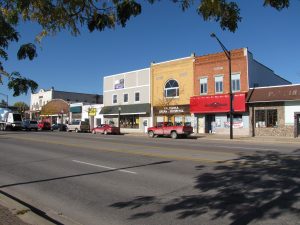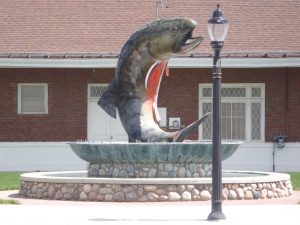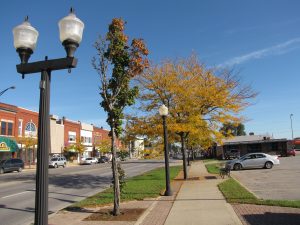Kalkaska is a quaint town in the heart of the Northern portion of Michigan’s Lower Peninsula. Combining its strong base of community values, its heritage of hard working people, and the natural beauty of the surrounding area, Kalkaska provides a bit of paradise for residents and visitors alike.
Hikers entering the town from the southwest come through the Pere Marquette State Forest. The North Country Trail exits the State Forest at Kalkaska Road. A nearly four-mile road walk winds past the fairgrounds and through the heart of Kalkaska, exiting town on County Road 612, with the road walk continuing past Blue Lake and Log Lake, and re-entering the Pere Marquette State Forest.

Shortly after Michigan became a state in 1840, the Kalkaska area was part of Wabassee County. In 1853 it became a part of Grand Traverse County and later, Antrim County. The first settlers arrived in 1855 and in 1871 the area was finally organized under the name of Kalkaska. The name Kalkaska is a Native American word sometimes said to mean “a flat of table land.” Others maintain that the word means “burned-over territory.” When the Native Americans inhabited the area, the land was covered with tall white pine trees. After the lumbermen came the land was cleared of its forests, the tops and branches burnt where they lay. As the lumberman moved north in search of more forest, they left behind small communities which evolved into farming-based towns.
Tourism in the Kalkaska area began around the turn of the century as people in the Midwestern cities discovered the county as a place to vacation in the great outdoors. The forests had sprouted young trees and bushes which provided food and cover for deer and other animals. The county soon became known for its hunting and fishing. In the 1930’s when the Great Depression hit the country, much of the privately owned land in the area reverted to the state. Today, almost half the land is owned by the State of Michigan. The DNR developed snowmobile, horse and hiking trails crisscrossing the area, connecting many camping and natural areas. Oil and gas was discovered over 30 years ago. Major drilling began in the 1970’s, resulting in more than 100 producing wells. Industry too has grown in the area, with 12 manufacturing plants recently beginning operations. Kalkaska has had the greatest percentage of population growth of any county in Michigan, increasing 100%. Per capita income has also increased dramatically.

The Log Lake County Park and Campground is located about two miles east of Kalkaska on Log Lake with a total of 44 campsites. Ten sites are full hookup, 28 have electric only, and six rustic sites. The campground also has indoor bathrooms and showers. For recreation, there is a sandy beach and swimming area, a playground, an 18-hole disc golf course, baseball field, horseshoe pits, a volleyball court, and WiFi internet access for campers. Concession is located in the office where you can purchase ice, drinks, snacks, firewood, fishing equipment, bait, discs, and other camping needs. For reservations call 231-258-2940.
The Cherry Street Market is a spin on a roadside fruit stand blended with greenhouse annuals and perennials, garden decor, fresh local fruits and vegetables, deli meats, cheeses, salads, fresh baked pies and cookies, locally baked bread, and jams and jellies.
Located in the downtown district of Kalkaska, the Trout Fountain is symbolic of Michigan’s official state fish, the brook trout. The fountain 18 feet high and the trout is 17 feet long. The fountain has wash stones from nearby Torch Lake and Michigan Petoskey stones in the base. The National Trout Festival is held annually the last weekend in April in Kalkaska.

The Kalkaska County Historical Museum is located in the Train Depot building downtown. The original building was built about 1873 but burned down in 1910. The present building was built immediately following and opened for business in 1911. It became a museum in 1970. The building was first rented from the village then leased in perpetuity. It is maintained by contributions, memberships and memorials. The original structure has been preserved and kept in much the same design as when it was used as a depot. (Only the occasional freight train goes past now.) Artifacts at the museum are all a part of Kalkaska history. Much information is available regarding people, places, dates, businesses, schools, churches, clubs, local government, industries, early exports and pioneer days. Visit explorekalkaska.com for information on hours of operation.
Sites at the Guernsey Lake State Forest Campground are available on a first-come, first-serve basis. No reservations. The campground offers 36 sites for tent and small trailer use, including some walk-in sites for hikers. Located adjacent Sand Lakes Quiet Area, ideal for nature observation, hiking, and camping. Rustic campground includes vault toilets and potable water from a well hand pump.
The Sand Lake Quiet Area is one of the most popular natural areas in Northwest Michigan. It offers 10 miles of hiking, biking and cross-country skiing. A hiking trailhead is located at Guernsey Lake State Forest Campground and a ski trailhead 5.5 miles southeast of Williamsburg via M-72 and Broomhead Road. The Quiet Area offers several miles of pristine trails that wind around many scenic little lakes that dot the preserve. Many of the skier-tracked trails cross over frozen lakes, which are also popular with local ice fishermen. Wildlife is abundant.
The Grand Traverse Chapter is responsible for the section of North Country Trail through Kalkaska.
Additional Resources
Header photo provided by Kalkaska Downtown Development Authority
